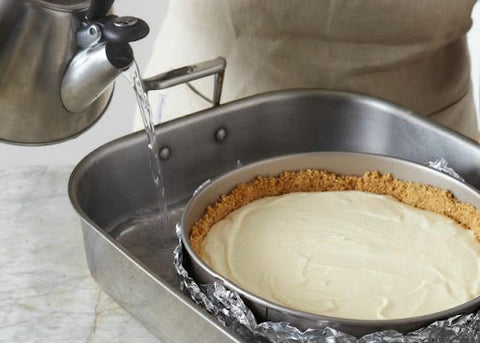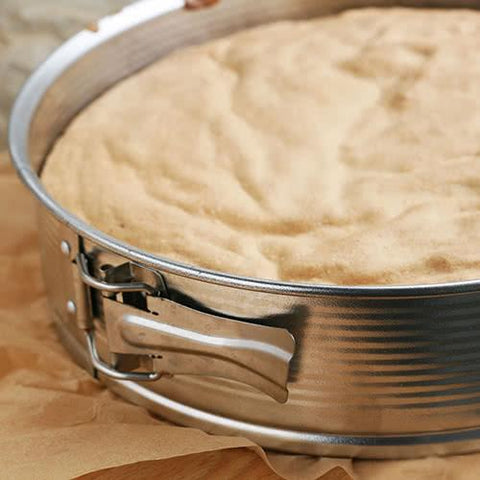Your Cart is Empty
FREE EXPEDITED SHIPPING
When you think of Japanese cuisine, you think of sushi and the infamous wobbly soufflé cheesecake. This light and airy dish is distinguished by its pillowy, soufflé-like texture created by incorporating meringue into the cheesecake batter, which is a dramatic contrast to a traditional dense cheesecake.
While you may not be able to travel to Japan to satisfy your craving, you can make the dessert at home using this simple recipe.

This particular recipe is a soufflé-style cheesecake that uses whipped egg whites in the cake batter and is baked in a water bath, giving it a light and fluffy texture. It's a cheesecake-flavored variant of Japanese soufflé pancakes.
It is called cheese soufflé or Japanese cheesecake soufflé because there are different types of cheesecake in Japan. To the world, this is known as Japanese cheesecake. It's also famously called a jiggly cake or Japanese cotton cheesecake due to its distinctive texture.

Japanese Cheesecake is also called Cotton Jiggly Cheesecake and its soft and smooth texture has taken the world by storm. Several people have compared its texture to chiffon. It has an airy texture and isn't as sugary as some of the commercially available American cheesecakes. It's a delicious way to end a dinner with dessert.
When it comes to who "invented" this version of the cheesecake, there is considerable debate, but chef Kazuno's account is the most well-known. Tomotaro Kuzuno, a Japanese chef, was influenced by a German cheesecake while traveling to Berlin in the 1960s. He was so enamored that he set out to create his own and market it in his homeland.
Because Japanese people are known for being health-conscious, this chef took this into account when developing the dish, which utilizes less fat and sugar than its foreign equivalents. To ensure that the cheesecake is light, the egg white and yolks are beaten separately in separate bowls. The classic 'bain-marie'(water bath) method is then used to prepare this cheesecake.

A bain-marie is another word for a hot water bath. It's commonly utilized in delicate dishes such as cheesecakes and other cuisines. The basic goal is to get a uniform bake by evenly heating the area around the dish.
A double boiler is another setup that is frequently referred to as a bain-marie. A double boiler is a piece of culinary equipment that consists of a pot of boiling water simmering on the burner and a bowl positioned above it.
You may build your own double boiler by stacking two smaller pots on top of each other and filling the below one with water. A double boiler is a set of two pots that link together and can be found in most culinary stores.
This popular Japanese dessert cuisine recipe is easy to make. To get started, follow the steps below:



1) Use a round cake pan with a 7-inch diameter and a 3-inch height. Set aside in the fridge after spreading unsalted butter thickly and lining the bottom with parchment paper.
2) Set aside the flour and corn starch after sifting them together.
3) Separate the yolks and whites from the eggs. In a bowl, refrigerate the egg whites.
4) To achieve a smooth cream texture, combine the cream cheese with a spatula.

5) In a mixing bowl, add the milk and cream cheese. Add a small amount of the milk and cream cheese mix at a time, stirring thoroughly after each addition.
6) One at a time, add the egg yolks and add the sugar, stirring well after each addition.
7) Sift the cream cheese batter into a large mixing basin to avoid lumps.
8) Mix in the lemon juice and lemon zest until everything is properly combined.

9) Combine the flour and cornstarch with the cream cheese mixture after sifting it.
10) Preheat the oven to 338 degrees Fahrenheit (170 degrees Celsius).
11) In another bowl, whisk the whites of the egg to make the meringue until bubbles emerge. Mix in the cream of tartar.
12) Add 1/3 of the caster sugar at a time and beat the egg whites every time the sugar is introduced. Whip until light and fluffy peaks form.

13) To stabilize the meringue form, remove the bowl from the stand and manually beat it.
14) Using a whisk, incorporate a quarter of the meringue into the batter you made before.
15) Use a spatula and carefully combine everything together.
16) Fill a circular cake pan with the batter that has been covered with parchment. Fill the tin to approximately 0.6 inches (1.5 cm) below the rim, then tap the tin on a worktop a number of times to remove the air bubbles.

17) Place it in a pan of water and cook it in a preheated oven. Reduce the heat to 320 degrees Fahrenheit (160 degrees Celsius) and bake for an additional 25 minutes.
18) Reduce the temperature to 284°F (140°C) and bake for another 55 minutes after the timer has expired.
19) After 55 minutes of baking at 284°F (140°C), turn off the oven. Let the cake cool for a further 30 minutes in the oven.
20) With the oven turned off, remove the pot of water and keep the oven door slightly ajar to enable the cake to cool.

21) Place the cheesecake in an airtight container, still in the round tin, and chill overnight.
22) Take the cake out of the pan and serve!

Before you start beating egg whites, ensure your whisk and mixing basin are clean and dry.

Avoid using plastic dishes, even if they are clean, as they may contain greasy residue that will prevent the egg whites from whipping properly.

Keep the beaters from getting immersed completely in the egg whites by using a wide bowl.

Check to see if your oven's temperature is accurate. When preparing Japanese soufflé cheesecake, the temperature is crucial. It will not rise well if the oven temperature is too low.

This cheesecake should not be baked in a tin with a removable base. It's unnecessary, as it can cause the bain-marie water to penetrate into the cake, resulting in a mushy base.

It may be tough to get this recipe right the first time, so if you're wondering why your Japanese cheesecake crack, be sure to grease the baking tin carefully the next time. If the cheesecake batter is not sufficiently greased as it begins to rise, it will be pulled by the parchment if it clings to it, breaking the top of the cake.

This basic cheesecake is incredibly adaptable. Because there are no additional flavors, you can serve it with a range of toppings:
There you have it. This easy Japanese cheesecake recipe may appear lengthy, but the end result is well worth the effort. This dish will delight your guests or children, and they will not be able to stop at just one slice.
While you're here, do check out Pepe Nero's baking kit for the complete baking set!
Comments will be approved before showing up.

